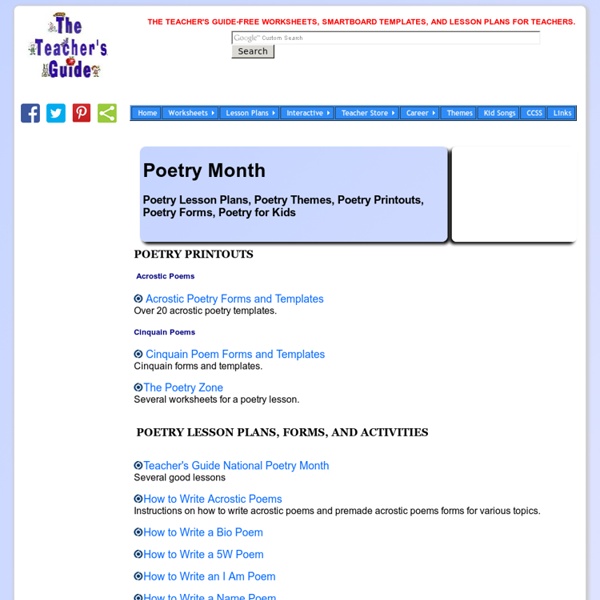Poetry Month Lesson Plans, Themes, Printouts, Templates

Poetry Printables
Fun, ready-to-print poetry activities are the perfect tools to bring words to life. Use these reproducibles to teach new concepts, reinforce past lessons, and inspire creativity. Poem in Your Pocket (PDF) - All Grades After introducing budding writers to the sounds and styles of poetry, invite them to copy down their favorite verse or write a new poem of their own and keep it their pockets to share with friends using this reproducible. Creepie Crawlies: Pick a Poem (Free Printable) — Grades K-2 The poetry in Creepy Crawlies has been thoughtfully written and compiled with kindergarten to second grade children clearly in mind. Weather Poems (PDF) — Grades K-2 From the brash, crash BLUNDER of thunder to a steaming, sizzling summery day, these poems will inspire students to write their own descriptive verses about the weather. My Bio-Poem (PDF) — Grades 1-2 Students will fill in the blanks of this outline to create poems about themselves.
edutopia
"As a child I walked with noisy fingers along the hemline for so many meadows back home." - Jewel I love to read poetry for many reasons, but some that strike me as being the most important are: Reading poetry relaxes me.Reading poetry makes me laugh!Reading poetry allows me to see into a deeper, more emotional part of myself. Do you feel the same way? We don't want to teach it.We're simply unsure of how to teach it.We didn't have a good experience with it ourselves. As April is National Poetry Month, a few weeks ago on New Teacher Chat, I choose the topic of sharing poetry teaching strategies for the simple reason that I wanted new (pre-service) teachers and their students to feel comfortable with experiencing poetry. 1. An "I Am" poem is a good way to introduce poetry to children, because it allows them to focus on their own characteristics. 2. Explain the process for shape poems, which entails starting with a shape and building a poem from there. 3. 4. 5.
10 Ways to Use Poetry in Your Classroom
Often when I mention poetry during a workshop, at least one teacher laments, "I would love to do more poetry with students, but there's so much else to teach in my curriculum!" What I try to encourage (and I'm often helped big time by the workshop participants) is for this teacher to consider using poetry within her curriculum, as an integral part of her language, reading, and writing lessons, rather than as an add-on. In other words, I ask her to find a purpose for poetry. Now, before you poetry purists flame me and cry out, "Poetry is in itself worth reading!" let me explain that I agree with you. I fondly recall organizing poetry picnics in third grade, where we would spread sheets and blankets on the field adjacent to the school playground and share favorite poems as we munched on morning snacks. But at the same time, I'm a realist. 1. Students are most receptive to new learning when they can connect it to what they already know. Recommended texts 2. 3. Recommended sites 4. 5. 6. 7.
Help a Child Write a Poem
Learn All Year Long Kids and teens should read and write even when they are out of school. Why is this so important? Download the flyer (PDF) ReadWriteThink has a variety of resources for out-of-school use. More Home › Parent & Afterschool Resources › Tips & How-To's Tip Why Use This Tip What To Do Why Use This Tip Children recognize the power of poetry—its ability to inspire emotions and the special pleasure you can get from memorizing a favorite poem or reading it again and again. Help a child recognize the elements of a poem and explore different ways of writing one, and you’ll also enable the child to become more familiar with the meaning of words and sentences, sentence structure, rhymes, and vocabulary. back to top What To Do Choose some books of poetry (see Additional Poetry Resources for some suggestions).
Related:
Related:



